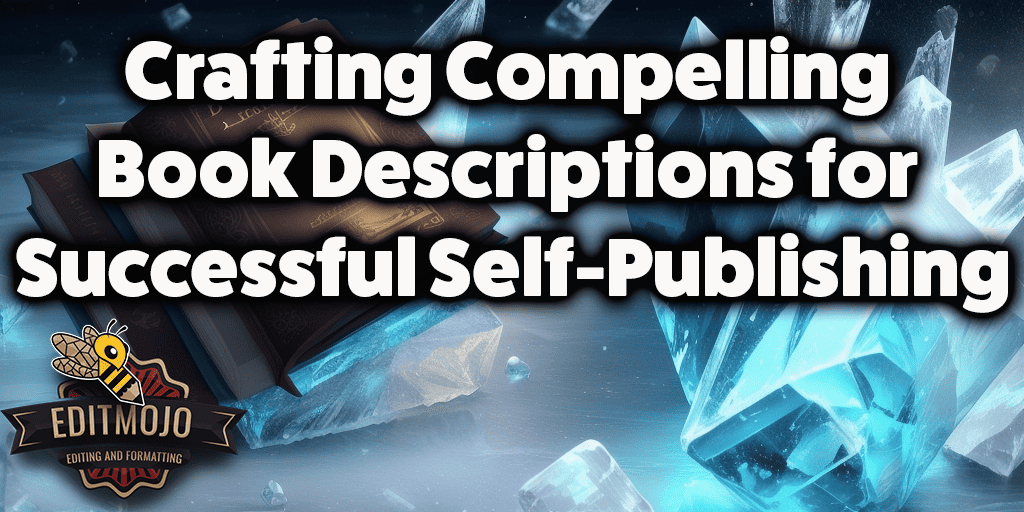Crafting Compelling Book Descriptions for Successful Self-Publishing
Crafting Compelling Book Descriptions for Successful Self-Publishing. In a world that’s constantly flooded with information, how do you make your self-published book stand out from the crowd? It’s a question that keeps many authors up at night.
But worry not. The answer lies in Crafting Compelling Book Descriptions for Successful Self-Publishing.
The Importance of a Riveting Book Description
You’ve spent countless hours weaving a rich narrative, developing complex characters, and perfecting every paragraph in your book. But the hard work doesn’t stop there. In the realm of self-publishing, your book’s description is just as vital as the story itself.
Why is that?

Well, think of your book description as a movie trailer. It sets the tone, provides a tantalizing glimpse into your narrative, and, most importantly, it entices readers to click ‘buy now’.
Without a captivating description, your book may be left unnoticed in the sea of literary content available online. With that in mind, let’s delve into the art of crafting compelling book descriptions.
Key Elements of a Compelling Book Description
When writing a book description, a few key elements should always be present:
- A Hook: This is your first sentence or two. It should be designed to immediately capture the reader’s interest.
- Synopsis: Give a brief overview of your story. Avoid revealing too much, but provide enough to pique curiosity.
- Unique Selling Proposition (USP): Highlight what sets your book apart from others in its genre.
- Call to Action (CTA): Encourage readers to make a purchase or read a sample.
Crafting each of these elements with care will undoubtedly create a powerful book description.
A Deeper Dive: The Hook
Imagine walking into a bookstore. There are thousands of titles vying for your attention. What makes you pick up one book over another? Often, it’s the first sentence that jumps out at you. That’s your hook.
A good hook should be intriguing, dramatic, and provocative. It can be a question, a bold statement, or a unique fact about your book. An excellent resource for hooks is Query Shark, a blog that critiques query letters and often focuses on that crucial opening line.

Crafting the Perfect Synopsis
The synopsis is where you provide a sneak peek into your story. But remember, less is more. You want to incite curiosity without giving away the entire plot.
The key to a great synopsis is balance. Give enough to spark interest but leave enough unanswered to prompt a purchase. If you’re struggling with this, Reedsy has a great guide on writing a captivating synopsis.
Your Book’s Unique Selling Proposition
The USP of your book is what sets it apart. It’s the ‘x-factor’ that differentiates your narrative from others in the same genre. Identifying and highlighting this in your book description can be a game-changer.
The Irresistible Call to Action
Lastly, the CTA. This is where you prompt the reader to take action. Whether it’s to “Buy Now,” “Read a Sample,” or “Add to Cart,” a well-crafted CTA is the final nudge readers need to engage with your book.
Remember, crafting compelling book descriptions is an art. It’s a blend of marketing, storytelling, and understanding your audience. But with practice, you can master it and see the impact.
Understanding Your Target Audience
Before you begin crafting your book description, it’s crucial to have a deep understanding of your target audience. Who are they? What do they enjoy? What kind of language resonates with them?
A well-targeted book description speaks directly to the reader’s interests, preferences, and desires. It can make the difference between a potential reader scrolling past your book or being compelled to click and buy.

For example, if your book is a sci-fi novel, your description should highlight elements that sci-fi fans love – advanced technology, otherworldly settings, complex plots, and so forth. A service like Kindlepreneur’s book description generator can help you tailor your description to your specific audience.
Using Keywords Effectively
A crucial aspect of book description that often goes overlooked is the use of keywords. Just as with search engine optimization (SEO), keywords can significantly impact your book’s visibility.
A keyword is a word or phrase that your target audience is likely to search for. Including these in your book description can make it more likely to appear in relevant search results, leading to increased visibility and potential sales. You can use tools like Publisher Rocket to identify relevant keywords for your book description.
The Art of Editing
Writing a compelling book description is only half the battle. Editing is where the magic truly happens. This is where you refine your words, eliminate unnecessary fluff, and make sure every sentence is powerful and purposeful.
Read your description aloud, have others review it, and don’t be afraid to revise multiple times. Just like your book, your description will benefit from a thorough editing process. Here’s an excellent guide on how to self-edit your work from Jerry Jenkins.
Conclusion
Crafting compelling book descriptions is a vital part of successful self-publishing. It requires a blend of creativity, marketing skills, and an understanding of your target audience. With these tips and resources, you’re well on your way to creating a book description that grabs attention and drives sales. Remember, every word counts, so make each one sing.
Now, it’s your turn. Start crafting your compelling book description today and let your story be heard. Good luck!
